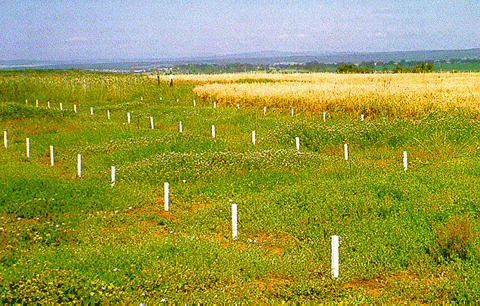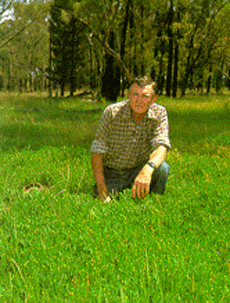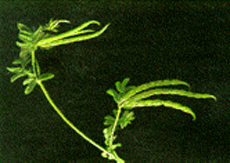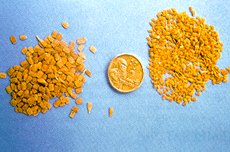
Serradella - Part A Introduction

Serradella (Ornithopus spp.) is one of the most important annual legumes for pastures in southern Australia. Its growth pattern is similar to that of sub clover but generally performs better on sandy acidic soils. It also grows well on many loams and non-acidic soils.
About 14 million hectares of the agricultural areas of NSW are moderately to severely acidic. Before the advent of serradella, few (if any) legumes survived or thrived on much of this country. As a consequence these soils were infertile; produced little worthwhile feed and were becoming increasingly degraded.
Currently there are about 400,000 ha of pasture in NSW that contain serradella as part of the species mix, and the area is expanding rapidly. The potential serradella area for the State is 2 million hectares. New varieties allow serradella to be grown successfully from the Western Division to the coast.
In many areas of light, acidic country, pasture production has lifted dramatically following the successful introduction of serradella. For example, in some places measurements have shown pasture production to increase from less than 500 kg of dry matter/ha for the autumn, winter and spring, to over 3000 kg/ha in an average year. In a good season, production has risen to over 6000 kg/ha. Stocking rates and stock quality have improved accordingly.
Serradella makes a big difference to the whole environment on many properties. It improves soil structure, nitrogen and organic matter levels, increases biological activity, and increases the numbers of soil organisms like earthworms. When combined with good management the increased plant residue also prevents or greatly reduces soil erosion risk, especially when sown with perennial summer grasses.
Origin

‘Ornithopus’ (derived from Greek) means ‘bird’s foot’ and describes the shape of the clusters of pods. Serradella is a native of the Mediterranean, and central and north-western Europe.
Botanists at the Royal Botanic Gardens first identified a naturalised yellow serradella from plants collected in the Sydney area in 1899. Pink serradella plants collected from the north coast were identified by the Royal Botanic Gardens in 1909.
About 1950, serradella was ‘discovered’ in Australia as a useful pasture legume by a Western Australian farmer Mr W. M. Pitman on his property, ‘Waroona’, 130 km south of Perth.
Small commercial sales of seed collected by Mr Pitman began in 1955. The cultivar was officially named after him in 1966.
Serradella was tested as a pasture plant in New South Wales as early as the 1930s. However, it was not until the 1970s that research showed serradella was a suitable pasture species for light soils in NSW.
Other varieties have been introduced from overseas via Western Australia, or developed in the Western Australian plant breeding program.
The first commercial grower of serradella in eastern Australia was Stan King, ‘Bondilla’, Binnaway (shown right). Carrying capacity on the light country on ‘Bondilla’ increased from less than 2 dse/ha to over 6 dse/ha following the introduction of serradella. The superior quick maturing variety King was named in his honour.
Description

Serradella is an autumn, winter and spring growing annual pasture legume with a spreading growth habit. Individual plants may reach over 1 m in diameter and set several hundred seed pods which are shown in the photo on the right. Plants dry off in spring when temperatures regularly exceed 28oC and soil moisture is depleted. Dry plant material is grazed by stock during summer. A new cycle starts in autumn when seeds germinate after suitable rains.
The leaves are pinnate (10 to 20 pairs of slender vetch-like leaflets). Groups of three to five small flowers form in late winter or spring (depending on the variety). From the flowers, slightly curved, hard, leathery seed pods develop. With some varieties the mature pods break into single seeded segments.
Serradella is deep rooted, in contrast to many other annual legumes like sub clover and medics. Moisture and nutrients are extracted from depths of up to 2 m or more below the soil surface. The deep rooting feature is responsible for the plant's ability to continue growing, flowering, and seeding under dry, warm spring conditions when more shallow rooted species quickly dry off.
Serradella types
There are five main types (species) of serradella.
Yellow serradella (O.compressus) varies greatly and has been the most important type grown in NSW. So far more than 10 varieties have been released. They range from early to very late maturity, upright to prostrate growth habit, and extremely high to only moderate tolerance to soil acidity. The seed types also vary among varieties; some seeds break easily from the pod and others stay intact. Yellow serradella varieties are almost all extremely hard seeded (60–95 percent) giving them a high degree of persistence.
The varieties generally have only a moderate to poor tolerance to long periods of waterlogging, particularly at higher temperatures.
Slender serradella (O. pinnatus) is especially suited to very light soils and soils prone to waterlogging. The seeds are very small and early seedling growth is generally inferior compared with that of yellow serradella. However, spring growth is outstanding. Slender serradella has a high percentage of hard seeds (generally 50–95 percent).
Only one variety (Jebala) has been officially released. However, a line called McFarlane that is distinct from Jebala is being commercially traded.
Pink serradella varieties (O. sativus), until now, have mainly been soft seeded. Pink serradella is a prolific grower, with high seed yields, and excellent tolerance to acidic soils. Due to its soft seed, stand life is often only two to three years. Pink serradella is a good companion to yellow serradella boosting pasture productivity in the first few years while the latter is building up seed reserves and becoming denser.
Hard seeded pink serradella varieties are being evaluated and the first of these are likely to be released by 2001–2003. Their growth is similar to the current popular variety Cadiz. The release of hard seeded Cadiz types should dramatically improve the long-term persistence of this valuable legume.
Other serradella species, including Moroccan serradella (O. isthmocarpus) and common birdsfoot serradella (O. perpusillus) are undergoing evaluation.
Growth & production
A major feature of serradella is its ability to ‘kick on’ when rain falls after a dry period in late winter or spring. In contrast, some species, such as sub clover, are often unable to recover and will not respond to a late spring/early summer rainfall after a prolonged dry spell.
In the early years of a serradella pasture’s life it should be grazed lightly during flowering and early seed development to ensure adequate seed set and the formation of a good ‘seed bank’. Once established serradella is well suited to continuous grazing.
Serradella is a nutritious plant that compares well with the other pasture legumes. Its quality is equivalent to that of most sub clover varieties, whether it is green, dry, or used for hay or silage. All classes of stock (cattle, sheep, goats and horses) find it palatable.
Soils
In many parts of NSW serradella grows better than any other pasture species on extremely acidic or sandy soils. Sub clover, for example, is relatively shallow rooted and cannot exploit the moisture or nutrients in deep sandy soils. Sub clover is also less tolerant of extreme soil acidity.
Serradella does grow on many soils suited to sub clover. It can even grow successfully on light soils that are neutral to slightly alkaline, but is not suited to heavy clay soils.
Shallow sandy and sandy loam soils that sometimes waterlog (for example because they have impervious clay subsoils) do not suit yellow serradella, especially in wet winters. However, slender serradella is well adapted to such soils.
Some serradella varieties have a remarkable tolerance to high levels of soluble aluminium in highly acid soils.
Rainfall
Current research shows that early maturing varieties can succeed in the lower and more variable rainfall areas, including parts of the eastern sector of the Western Division. Early maturing varieties begin to flower in late July or early August and can set seed in harsher conditions. Because yellow serradella varieties have a high hard seed content, regeneration can occur once a seed bank has been developed, even if seeding is missed in some years because of drought.
Serradella has been grown successfully 80 km north-west of Walgett since the late 1980’s. There is every indication the pasture will last indefinitely, despite the occurrence of frequent droughts.
Early maturing varieties should do well in areas with average annual rainfalls as low as 400 mm in north-western NSW and 300 mm in south-western NSW.
Mid and later maturing varieties have proven persistent and productive on the coast, tablelands and slopes in areas with annual rainfalls ranging from 400 mm to 1000 mm. Earlier maturing varieties are generally preferred in the lower rainfall plains environments (sometimes in mixtures with mid-season types).
Temperature
Although serradella’s winter growth is restricted by low temperature, it tolerates frost.
Being a winter growing annual, serradella normally germinates with the first reasonable autumn rains. Its winter growth is very much moisture and temperature dependent. In some colder tableland areas winter growth can be very slow, especially when the seasonal break is late (for example late May). It dries off when spring soil moisture is depleted and temperatures increase into the summer.
Most serradella varieties have an indeterminate growth habit that allows them to continue flowering and setting seed as long as moisture is adequate and temperatures are mild. If there is a dry, hot spring, serradella may dry off as early as September, but in mild, wet springs it commonly continues to grow actively until Christmas.
Seed treatment
When harvested, the serradella seed is encased in a hard, leathery pod coat (hull). Most seed was once marketed in this hulled form. Hulled (left) and dehulled serradella seed (right) are shown in the photo on the right. Most yellow serradellas have a high percentage of hard seed prior to dehulling or partial dehulling, a feature that helps ensure long-term persistence in the field.
In most yellow and slender serradella varieties the hull prevents moisture getting through to the seed and inhibits germination. These serradellas generally produce a very high proportion of hard seed (85–95 percent), and unless the seed is treated it germinates poorly.
In the paddock, unless there is a heavy insulating mat of plant residue, exposure to day and night temperature fluctuations over summer and autumn causes the hull to soften. Although a considerable proportion of seed can remain hard for one to several years (and therefore doesn’t germinate), generally more than enough seed softens to ensure adequate regeneration from season to season.
Harvested seed, however, is generally stored in conditions where temperatures fluctuate little. In these circumstances, seed dormancy remains strong.
Although some hard seed is desirable when sowing new pastures (especially in drier environments where it is important to have a seed reserve in case the first germination fails), an adequate percentage of soft, viable seed is required. If there is not enough soft seed, new serradella pastures are not dense enough and take some years to develop maximum productivity. To overcome the problem (and to avoid the necessity for high and expensive seeding rates, or unacceptable pasture production losses in early years), the seed can be treated to break dormancy.
Two techniques have been developed to lift the percentage of soft, viable seed; the removal of the seed hull and hot water treatment of untreated seed.
To obtain dehulled seed the part of the seed pod that clings tightly around the seed is mechanically removed. The technique commonly increases soft seed content from between 1 and 10 per cent to between 60 and 95 per cent. There are twice as many dehulled yellow serradella seeds to the kilogram than hulled seeds (about 400,000 seeds/kg compared with 200,000 seeds/kg, and there is considerable variety variability).
Some seed is traded as ‘enhanced’, this generally comprises a mixture of dehulled seed and hulled seed.
Hot water treatment of seed is an older method of increasing the level of soft seed. Hot water treatment involves immersing pods in water just on the boil for 1 to 2 minutes and then quickly cooling and drying them. The germination percentage generally increases from 1 to 20 per cent to 15 to 45 per cent. This is the less preferred method as it may kill any soft seed present.
Buying seed

Seed should to a large degree be priced on the basis of the number of viable soft seeds/kg. A typical example for dehulled seed is a 70 per cent viable soft seed content and a total of 400,000 seeds/kg. In this example 280,000 seeds/kg are ready to germinate as soon as conditions are suitable following sowing.
A percentage of hard seed is important in drier environments. The hard seeds become a viable reserve for later seasons if establishment fails in the first year because of factors such as drought.

